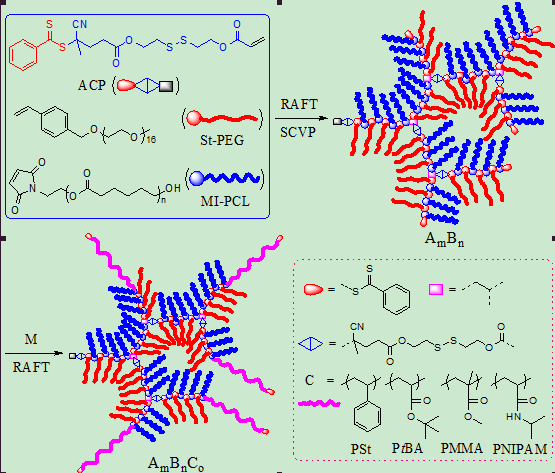Synthesis and properties of multicleavable amphiphilic dendritic comblike and toothbrushlike copolymers comprising alternating PEG and PCL grafts
Macromolecules, 2013, 46, 1325−1336.
Meijing Zhang (张美精), Huanhuan Liu (刘欢欢), Wei Shao (邵威), Ke Miao (缪柯), Youliang Zhao (赵优良)*
Facile construction of novel functional dendritic copolymers by combination of self-condensing vinyl polymerization, sequence-controlled copolymerization and RAFT process was presented. RAFT copolymerization of a disulfide-linked polymerizable RAFT agent and equimolar feed ratio of styrenic and maleimidic macromonomers afforded multicleavable AmBn dendritic comblike copolymers with alternating PEG (A) and PCL (B) grafts, and a subsequent chain extension polymerization of styrene, tert-butyl acrylate, methyl methacrylate, and N-isopropylacrylamide gave AmBnCo dendritic toothbrushlike copolymers. (PEG)m(PCL)n copolymers obtained were of adjustable molecular weight, relatively low polydispersity (PDI = 1.10–1.32), variable CTA functionality (fCTA = 4.3–7.5), and similar segment numbers of PEG and PCL grafts, evident from 1H NMR and GPC-MALLS analyses. Their branched architecture was confirmed by (a) reduction-triggered degradation, (b) decreased intrinsic viscosities and Mark–Houwink–Sakurada exponent than their “linear” analogue, and (c) lowered glass transition and melting temperatures and broadened melting range as compared with normal AmBn comblike copolymer. In vitro drug release results revealed that the drug release kinetics of the disulfide-linked AmBn copolymer aggregates was significantly affected by macromolecular architecture, end group and reductive stimulus. These stimuli-responsive and biodegradable dendritic copolymer aggregates had a great potential as controlled delivery vehicles.

链接://pubs.acs.org/doi/abs/10.1021/ma3025283